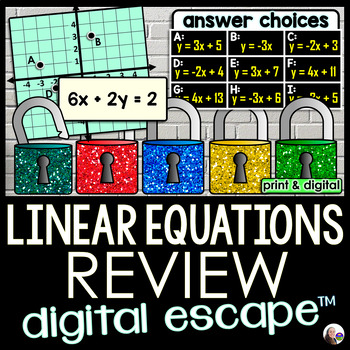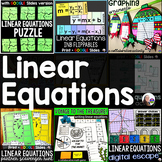Linear Equations Review Digital Math Escape Room Activity
- PDF
- Google Apps™

What educators are saying
Also included in
- This bundle includes a variety of interactive printable and digital linear equations activities that will keep your students engaged as they are learning, practicing an reviewing linear equations. Inside this bundle are digital math escape rooms, math pennants, a linear equation project, partner scaPrice $27.00Original Price $44.50Save $17.50
- Are you teaching summer school algebra? There are two ways to approach summer school algebra: as a punishment for slacking off all year or as an amazing opportunity to turn math attitudes around! There are reasons for taking either approach, but which has the possibility of changing a kid's life forPrice $40.00Original Price $72.00Save $32.00
- This bundle of digital algebra escape rooms will engage your algebra 1 students while being a breeze to assign.Topics covered: Solving equations and inequalities, quadratic word problems, graphing linear equations and inequalities, linear equations word problems, solving absolute value equations andPrice $50.00Original Price $90.00Save $40.00
Description
An engaging algebra escape room activity for reviewing linear equations. Questions are grouped 4 per puzzle, resulting in five 4-letter codes that will unlock all 5 locks.
Questions include:
- write point-slope equations given a coordinate point and a slope,
- convert from standard form to slope-intercept form,
- write slope-intercept equations given a coordinate point and a slope,
- identify slope-intercept equations of lines,
- write slope-intercept equations given 2 coordinate points.
The entire activity is housed in one GOOGLE Form. There are no links to outside websites. The 4-letter codes are set with answer validation so that students cannot move to the next puzzle until they enter the correct code. Includes answer key.
To add the digital escape room to your Google Drive: please open the PDF and click the button on page 3.
A printable PDF version has also been added to the file. Students can work in groups, each group starting at a different puzzle. Once done, students check the NEXT STEP box for which puzzle to visit next.
Included in: Algebra Activities Bundle
You may also like:
Quadratic Word Problems Digital Math Escape Room








